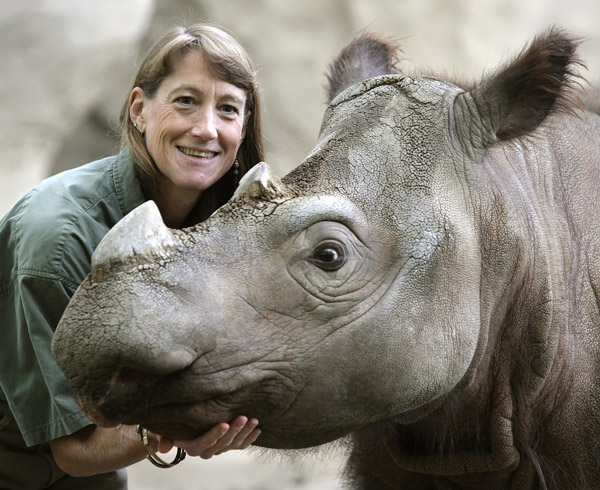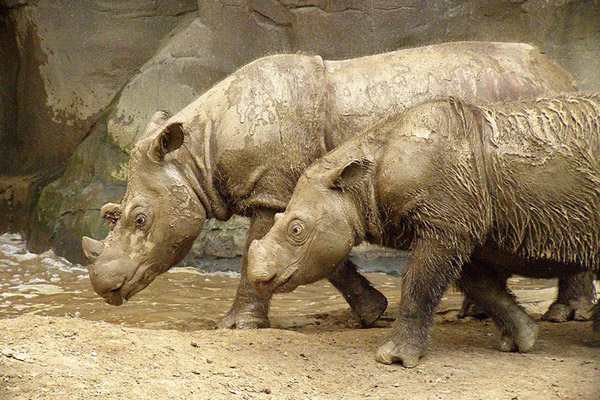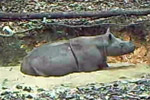Just over two weeks ago, conservationists in the Malaysian state of Sabah managed to finally catch a wild Sumatran rhino female after months of failed attempts; the female, named Iman, was quickly helicoptered to a semi-wild rhino reserve in hopes that she may breed with the resident male, Tam. But following such hopeful events, comes bad news thousands of miles away: a young female rhino, named Suci, died over the weekend at the Cincinnati Zoo. This leaves only nine Sumatran rhinos (Dicerorhinus sumatrensis) in captivity (three in Sabah, five in Sumatra, and one in Cincinnati) and a wild population that scientists say numbers less than a hundred.
“Today the Cincinnati Zoo has lost one of its most beloved and charismatic animals. Suci was a symbol of hope for her entire species, one that is quickly losing ground in the wild, and her absence will leave a great hole in our hearts,” Terri Roth, Director of Cincinnati Zoo’s Lindner Center for Conservation & Research of Endangered Wildlife (CREW), said on Sunday, telling local press, “It just kind of hits you like a semi.”
Born in 2004, nine-year-old Suci died young for a Sumatran rhino, whose lifespan is thought to be 35-40 years in captivity. Zoo officials say she died from a “complex disease”, believed to be hemochromatosis, after undergoing treatment for months. Suci’s mother also suffered from hemochromatosis. Experts will conduct an necropsy this week but won’t have results for months. The loss of Suci is all the more tragic in that experts had hoped to mate her either with Tam or her brother Harapan in the next few years.

Sumatran rhino, Suci, with Terri Roth. Photo by: Photo by Michael E. Keating.
Suci was the child of Emi and Ipuh, who produced three Sumatran rhinos at Cincinnati Zoo, the first successful Sumatra rhino births in over a century. Since then, only one of the children, a male named Andalas, has successfully mated after being transported to Indonesia. In 2012 Andalas and Ratu, a female captured in Sumatra, produced a healthy baby rhino at Way Kambas Rhino Sanctuary on the island using techniques developed by CREW.
Sumatran rhinos once roamed much of Southeast Asia as far west as India. However, decades of poaching and deforestation destroyed populations one-by-one until only a few survived made up of two subspecies: one in Borneo and the other on Sumatra. Today the species faces major fertility problems and tiny remnant population increasingly cut off from each other.
“Remaining wild Sumatran rhinos are generally living in marginal habitats, as the species has been wiped out of all the best habitats over the past few millenia,” John Payne, the executive director of the Borneo Rhino Alliance (BORA) told mongabay.com. BORA was instrumental in capturing Iman, who was likely living in a forest bereft of other rhinos.
Payne goes on, “After 37 years of being involved in Sumatran rhino conservation work, my conclusion is that the species is doomed if left in the wild. This has little to do with poaching, and nothing to do with logging, encroachment or habitat loss. The issue is that fewer and fewer of the pitiful number of Sumatran rhinos left in the wild enjoy the the ideal combination of being fertile, un-related and in regular breeding contact. Humans now have to decide either to let the species go extinct naturally, or to step in and to collaborate with the single common purpose of boosting rhino pregnancies.”
In a bid to save the species, conservationists have agreed at least in principle to mixing the subspecies and plans were in place to transport Tam (from the Bornean subspecies) to the U.S. to attempt mating with Suci, who was in the Sumatran subspecies. Hopes now turn to the newly caught female in Borneo, Iman.

Mother Emi with young Harapan, her last baby. Emi died in 2009. Photo by: Charles W. Hardin/Creative Commons 2.0.
However Payne says overall progress has been stymied by an unwillingness to collaborate.
“Even at this stage, Governments of Indonesia and Malaysia are not collaborating, while the world specialists in captive rhino breeding in USA and Germany are not talking to each other. It is long overdue that they must do so,” he said. “We should now think seriously in terms of bringing Sumatran rhinos together in large, fenced, managed facilities, perhaps on a specially-managed area of non-government owned farm land. This is how the African rhinos and two bison species were saved from extinction a century ago.”
White rhinos were thought to be extinct at the end of the 19th Century until 20 individuals were discovered in South Africa. These twenty individuals were bred and released into the wild over several decades. Today, there are over 17,000 white rhinos in Africa, making it the most secure of the five rhino species.
Payne says even a well-managed mature palm oil plantation with woody weeds could provide “fantastic Sumatran rhino habitat” and offer protection.
“I hope one of the big corporations would take up such a challenge, and that governments and concerned NGOs would have the vision to give it a try,” he adds.
Currently the Borneo Rhino Sanctuary remains unfinished despite promises from the Sabah government, leaving Tam, Iman, and another female, Puntung, in temporary facilities. Sabah, unlike Sumatra, has yet to see a successful birth.
For their part, Cincinnati Zoo says the loss of Suci will not change their involvement in saving the Sumatran rhino from extinction.
“The Cincinnati Zoo has been committed to saving the Sumatran rhino for 25 years, and we plan to keep working to ensure this species will still be around a century from today,” said Thane Maynard, Executive Director of the Cincinnati Zoo. The zoo is still home to one Sumatran rhino, Suci’s younger brother, Harapan, who was born in 2007. The zoo was planning to attempt mating between the brother and sister as well, according to the Associated Press.
“The death of Suci should definitively not be a signal to stop captive breeding efforts,” concluded Payne. “Instead, it should draw the relevant parties closer, to collaborate on deciding exactly how to facilitate every individual remaining Sumatran rhino to play a role in contributing to breeding more rhinos.”
Hairy, two-horned, and small (compared to other rhino species), Sumatran rhinos are the only surviving members of the genus, Dicerorhinus. Evolutionarily they are believed to be the oldest rhinos on Earth and likely the most closely related to the extinct woolly rhinoceros.

Iman wallowing in the mud. Photo by: John Payne/BORA.
Related articles
Meet Iman: the Sumatran rhino’s newest hope for survival

(03/24/2014) Hopes for one of the world’s most imperiled megafauna rose this month when wildlife conservationists succeeded in catching a female Sumatran rhino named Iman in the Malaysian state of Sabah. The female, which experts believe to be fertile, has since been successfully transferred via helicopter to the Borneo Rhino Sanctuary where experts plan to mate her with the local male, Tam. Located in Tabin Wildlife Reserve, the Borneo Rhino Sanctuary is an uncompleted semi-wild enclosure and home to one of several last-ditch efforts to save the vanishing species from extinction.
Conservationists catch wild Sumatran rhino, raising hope for world’s most endangered rhinoceros

(03/12/2014) Conservationists have succeeded in catching a wild Sumatran rhino in the Malaysia state of Sabah in Borneo, according to local media reports. Officials are currently transferring the rhino, an unnamed female, to a rhino sanctuary in Tabin National Park where experts will attempt to mate it with the resident male, Tam. The Sumatran rhino (Dicerorhinus sumatrensis) is one of the world’s most imperiled species with less than 100 individuals left.
Requiem or recovery?: the Sumatran rhino 200 years after its description

(01/08/2014) In 1893, William Bell, a surgeon in the service of the Dutch East India Company stationed in Bencoolen, Sumatra, examined the body of a dead rhinoceros. The animal, a male, was relatively small as rhinoceroses go, measuring only four feet four inches at the shoulder and eight feet five inches from its nose to the tip of its tail. Dr. Bell noted that the animal resembled a large hog and judged it to be a young individual based upon the condition of the bones and teeth.
Javan rhino population jumps by over 10 percent
(03/04/2014) The Javan rhino population has increased by over ten percent from 2012 to last year, according to new figures released by Ujung Kulon National Park. Using camera traps, rangers have counted a total of 58 Javan rhinos, up from 51 in 2012. Although the species once roamed much of Southeast Asia, today it is only found in Ujung Kulon National Park in western Javan and is known as one of the most imperiled mammals on the planet.
WWF risking Sumatran rhinos by releasing camera trap images, says scientist

(10/09/2013) On October 2nd, WWF released camera trap videos of Sumatran rhinos surviving in Kalimantan, Indonesian Borneo. The conservation organization had already announced in April that they had evidence of at least one Sumatran rhino in the province, but the new images confirmed what is likely to be a small surviving population. While this is good news for an animal on the edge of extinction, Erik Meijaard, a researcher who has worked in Indonesia for over 20 years, says WWF has made a mistake publicizing the news around the world, noting ‘the last thing those rhinos need is publicity.’